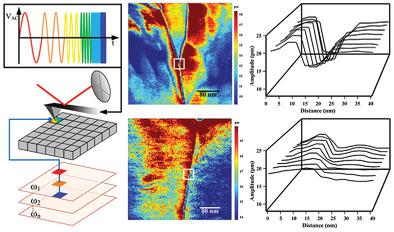当前位置:
X-MOL 学术
›
Small Methods
›
论文详情
Our official English website, www.x-mol.net, welcomes your
feedback! (Note: you will need to create a separate account there.)
Spatially Resolved Electrochemical Strain of Solid‐State Electrolytes via High Resolution Sequential Excitation and Its Implication on Grain Boundary Impedance
Small Methods ( IF 10.7 ) Pub Date : 2020-09-01 , DOI: 10.1002/smtd.202000308 Junxi Yu 1, 2 , Shanshan Duan 3 , Boyuan Huang 4, 5 , Hongyun Jin 3 , Shuhong Xie 2 , Jiangyu Li 1, 5
Small Methods ( IF 10.7 ) Pub Date : 2020-09-01 , DOI: 10.1002/smtd.202000308 Junxi Yu 1, 2 , Shanshan Duan 3 , Boyuan Huang 4, 5 , Hongyun Jin 3 , Shuhong Xie 2 , Jiangyu Li 1, 5
Affiliation

|
Solid‐state electrolytes have great potential in solving the intrinsic safety issues of conventional lithium‐ion batteries utilizing liquid electrolytes, and there is a tremendous effort in developing solid‐state electrolytes with improved ionic conductivity via microstructure engineering spanning multiple length scales. Nevertheless, there still lacks an effective method to probe the local ionic conductivity at the nanoscale with sufficient resolution, and thus how the microstructure impacts macroscopic ionic conductivity of solid‐state electrolytes remains inadequately understood. Here, the newly developed sequential excitation (SE) electrochemical strain microscopy is applied to spatially resolve local electrochemical processes at the nanoscale, unraveling the ionic dynamics of grain boundary in Li1.3Al0.3Ti1.7(PO4)3 solid‐state electrolytes that correlate well with macroscopic impedance analysis. The high‐conductivity sample possesses comparable ionic dynamics at grain boundary and within grain interior, while low‐conductivity sample exhibits much higher resistance at the grain boundary, even though the conductivity of its grain interior is comparable to high‐conductivity sample. The study thus provides direct experimental evidence on the bottlenecking grain boundaries in ionic conduction, and offers a powerful tool to study local ionic dynamics at the nanoscale in one‐to‐one correspondence to the microstructure features.
中文翻译:

高分辨率顺序激励的固态电解质空间分辨电化学应变及其对晶界阻抗的影响
固态电解质在解决传统的使用液体电解质的锂离子电池的内在安全性问题方面具有巨大潜力,并且人们正在通过跨多个长度尺度的微结构工程来开发具有改善的离子电导率的固态电解质。然而,仍然缺乏有效的方法来以足够的分辨率探测纳米级的局部离子电导率,因此,对微观结构如何影响固态电解质的宏观离子电导率的了解还不够。在这里,新开发的顺序激发(SE)电化学应变显微镜技术被用于在空间上解决纳米尺度上的局部电化学过程,从而揭示了Li 1.3 Al中晶界的离子动力学。0.3 Ti 1.7(PO 4)3固态电解质,与宏观阻抗分析密切相关。高电导率样品在晶界和内部具有可比的离子动力学,而低电导率样品在晶界处具有更高的电阻,即使其内部的电导率可与高电导率样品媲美。因此,这项研究提供了有关离子传导瓶颈晶粒边界的直接实验证据,并提供了一个强大的工具来研究纳米尺度上与微观结构特征一一对应的局部离子动力学。
更新日期:2020-10-07
中文翻译:

高分辨率顺序激励的固态电解质空间分辨电化学应变及其对晶界阻抗的影响
固态电解质在解决传统的使用液体电解质的锂离子电池的内在安全性问题方面具有巨大潜力,并且人们正在通过跨多个长度尺度的微结构工程来开发具有改善的离子电导率的固态电解质。然而,仍然缺乏有效的方法来以足够的分辨率探测纳米级的局部离子电导率,因此,对微观结构如何影响固态电解质的宏观离子电导率的了解还不够。在这里,新开发的顺序激发(SE)电化学应变显微镜技术被用于在空间上解决纳米尺度上的局部电化学过程,从而揭示了Li 1.3 Al中晶界的离子动力学。0.3 Ti 1.7(PO 4)3固态电解质,与宏观阻抗分析密切相关。高电导率样品在晶界和内部具有可比的离子动力学,而低电导率样品在晶界处具有更高的电阻,即使其内部的电导率可与高电导率样品媲美。因此,这项研究提供了有关离子传导瓶颈晶粒边界的直接实验证据,并提供了一个强大的工具来研究纳米尺度上与微观结构特征一一对应的局部离子动力学。











































 京公网安备 11010802027423号
京公网安备 11010802027423号